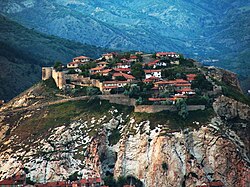İskilip
| İskilip | |
|---|---|

Citadel of İskilip
|
|
| Coordinates: 40°44′10″N 34°28′26″E / 40.73611°N 34.47389°ECoordinates: 40°44′10″N 34°28′26″E / 40.73611°N 34.47389°E | |
| Country |
|
| Province | Çorum |
| Government | |
| • Mayor | Recep Çatma (AKP) |
| • Kaymakam | Mehmet Yılmaz |
| Area | |
| • District | 1,066.60 km2 (411.82 sq mi) |
| Elevation | 750 m (2,460 ft) |
| Population (2012) | |
| • Urban | 20,405 |
| • District | 37,307 |
| • District density | 35/km2 (91/sq mi) |
| Post code | 194xx |
| Climate | Csb |
| Website | www |
İskilip is a district of Çorum Province of Turkey, on the left bank of the River Kızılırmak, located at 56 km from the city of Çorum, 100 miles (160 km) northeast of Ankara and 60 miles (100 km) southeast of Kastamonu. It covers an area of 1,187 km², and has an elevation of 2460 ft (750 m). The population is about 39,124, of which 20,660 live in the town of İskilip (as of 2010). The mayor is Recep Çatma (AKP).
Former names included Iskila (the name given to the area in Hittite times, Asklepios (Aesculapius) (in ancient Greek), Blocium / Bloacium, İmad, Iskelib, İskelib (the ancient name being restored in the Seljuk Turkish era) and Direklibel.
İskilip lies on a well-watered plain, several miles off the road between Çankırı and Amasya among wooded hills, at the foot of a limestone rock crowned by the ruins of an ancient fortress now filled with houses. Near the town are saline springs, from which salt is extracted. The climate is dry. The highest point is Mount Teke (1700m). The local economy depends on agriculture, especially grains and pulses, and forestry. Iskilip lies on the North Anatolian geological fault line.
By one calculation the geographic center of all land area on the earth surface, is a mile or so to the northeast of Iskilip town, making it the centre of the world.
People have been attracted to the saline springs of İskilip since the earliest times, and the town stands on a route through the mountains to the Black Sea coast. Therefore, this is one of the longest-settled areas of Anatolia; copper was smelted here in ancient times, when the plain was settled by the Hittite and Hatti civilizations (from 3000 BC). Rock carvings on the hill of Yivlik are said to date to the Hittite period.
...
Wikipedia

